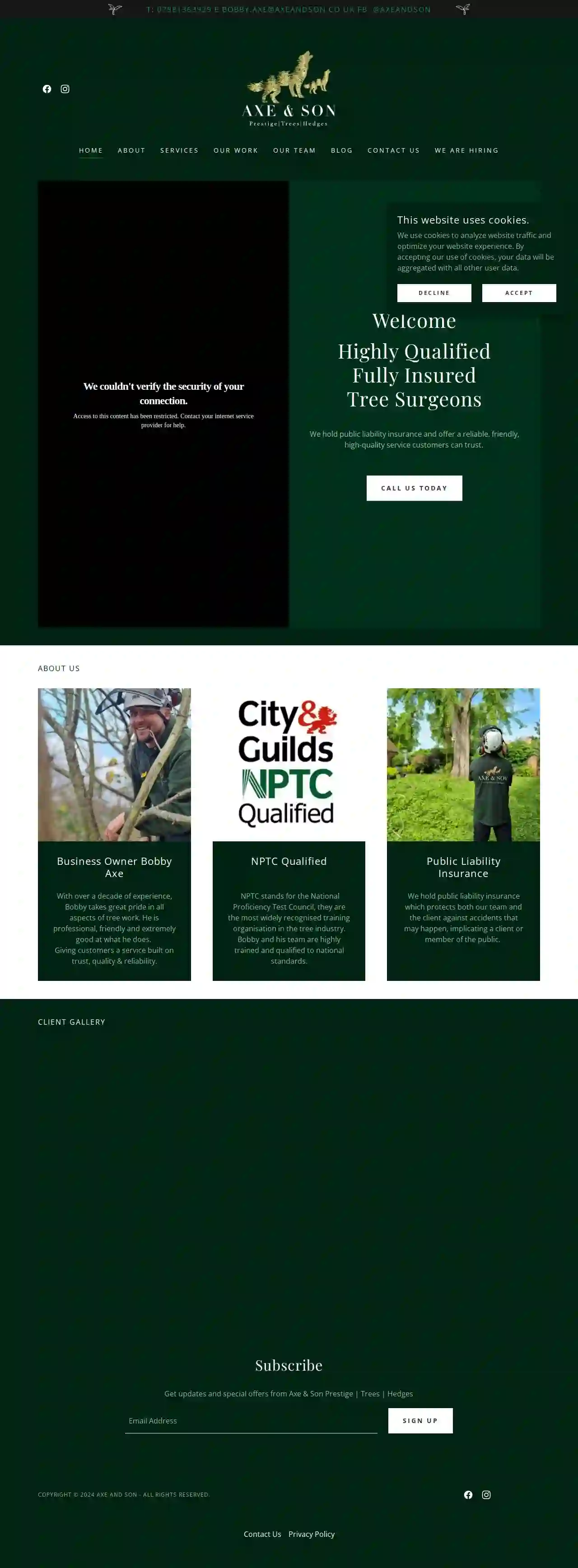Tree Trimming Witham
Top Tree Trimming Service in Witham
Get up to 3 Tree Pruning quotes for your project today! Compare profiles, reviews, accreditations, portfolio, etc... and choose the best service.

The Woodsman | Tree Surgeon and Forestry
515 reviewsAlton, ALTON, GBTHE WOODSMAN is a forestry and tree care specialist serving both domestic and commercial clients in Alton, Hampshire. Our team of skilled tree surgeons are dedicated to providing professional tree services to the highest standards of safety and quality. We hold NPTC qualifications, ensuring our work meets industry standards. We understand the risks trees can pose to property and utilize leading techniques for safe removal, even in challenging locations. Our expertise allows us to assess each situation and develop a tailored approach, minimizing disruption and damage. Whether you need a single tree removed or extensive tree cutting services, we have the knowledge, experience, and latest equipment to handle any project. At THE WOODSMAN, customer satisfaction is paramount. We aim to exceed your expectations with a reliable and professional service, completing all work to your specifications. Contact us today to discuss your tree cutting requirements and let our skilled team take care of your tree removal needs with professionalism and expertise.
- Services
- Why Us?
- Gallery
Get Quote- Vi
Visual Tree Care
51 reviewsWitham, GB- Services
- Why Us?
Get Quote - Br
Bright Tree Care
517 reviewsWitham, GB- Services
- Why Us?
Get Quote 
Axe & Son Prestige | Trees | Hedges
545 reviewsBasingstoke, GBAxe & Son Prestige Trees | Hedges is a family-run business that offers a high-quality service built on trust, quality, and reliability. With over a decade of experience, Bobby Axe, the business owner, takes great pride in all aspects of tree work. He is professional, friendly, and extremely good at what he does. The company holds public liability insurance and is NPTC qualified, ensuring that customers can trust and rely on their services. They offer a range of services, including hedge maintenance, tree pruning and felling, and planting and stump removal. With a focus on customer satisfaction, they strive to provide a service that exceeds expectations.
- Services
- Why Us?
- Accreditations
- Our Team
- Gallery
Get Quote- Wi
Witham Tree services
516 reviewsWitham, GB- Services
- Why Us?
Get Quote - TC
TCS Tree Care Ltd
56 reviewsWitham, GB- Services
- Why Us?
Get Quote - J
J N Treescape Ltd
51 reviewsWitham, GB- Services
- Why Us?
Get Quote - MW
MWU Tree Services
56 reviewsWitham, GB- Services
- Why Us?
Get Quote - Oa
Oakfall tree surgery
59 reviewsWitham, GB- Services
- Why Us?
Get Quote - Tr
Tree of Life Arboriculture
536 reviewsWitham, GB- Services
- Why Us?
Get Quote
Over 8,530+ Tree Service Companies onboarded
Our tree removal contractors operate in Witham & surrounding areas!
LocalTreeSurgeon has curated and vetted the Best Tree Surgeons in Witham. Find a top & reliable pro today.
Frequently Asked Questions About Tree Trimming
- Size and type of tree: Larger trees and those with dense canopies generally require more time and effort, increasing the cost.
- Accessibility: Difficult-to-reach trees may require specialized equipment like cranes or lifts, thus increasing costs.
- Type of trimming: Crown reduction, thinning, or shaping can have different pricing structures.
- Location: Labor costs vary regionally.
- Number of trees: The number of trees you need trimmed will affect the total price.
- Stronger structure: Removing weak or damaged branches improves structural integrity.
- Better growth: Trimming allows more light and air to reach the interior of the canopy, encouraging healthy growth.
- Improved appearance: Keeps your trees looking beautiful and well-maintained.
- Disease prevention: Removing dead or diseased branches helps prevent the spread of infection.
- Safety: Removing overhanging branches reduces the risk of damage to your property.
- Dead or dying branches: These are a clear sign that pruning is necessary, both for aesthetics and safety. Dead branches can fall unexpectedly.
- Overgrown branches: Branches that overhang buildings, roads, or power lines pose safety hazards and should be trimmed.
- Crossing or rubbing branches: Branches that cross or rub against each other can cause damage, creating wounds that are vulnerable to disease and insects.
- Weak or damaged branches: Branches that are damaged or weak can break easily and should be removed to prevent harm.
- Unattractive growth: Trees may need trimming to improve their appearance and maintain a balanced shape.
- Disease or pest infestation: Trimming can help remove infected or infested branches.
- Use sharp, clean tools: Dull tools can cause tearing or crushing of the branches and increase the risk of disease.
- Wear safety gear: Protective clothing, eye protection, and gloves are crucial.
- Inspect the tree: Identify the branches that need pruning, such as dead or damaged branches.
- Use proper pruning techniques: Make clean cuts, following the branch collar. Don't remove too much of the crown in a single session.
- Dispose of the branches responsibly: Chip the debris or dispose of it according to local guidelines.
How much does tree trimming cost near me?
Why is tree trimming important?
How to tell if tree trimming is needed?
How to prune a tree safely?
How much does tree trimming cost near me?
- Size and type of tree: Larger trees and those with dense canopies generally require more time and effort, increasing the cost.
- Accessibility: Difficult-to-reach trees may require specialized equipment like cranes or lifts, thus increasing costs.
- Type of trimming: Crown reduction, thinning, or shaping can have different pricing structures.
- Location: Labor costs vary regionally.
- Number of trees: The number of trees you need trimmed will affect the total price.
Why is tree trimming important?
- Stronger structure: Removing weak or damaged branches improves structural integrity.
- Better growth: Trimming allows more light and air to reach the interior of the canopy, encouraging healthy growth.
- Improved appearance: Keeps your trees looking beautiful and well-maintained.
- Disease prevention: Removing dead or diseased branches helps prevent the spread of infection.
- Safety: Removing overhanging branches reduces the risk of damage to your property.
How to tell if tree trimming is needed?
- Dead or dying branches: These are a clear sign that pruning is necessary, both for aesthetics and safety. Dead branches can fall unexpectedly.
- Overgrown branches: Branches that overhang buildings, roads, or power lines pose safety hazards and should be trimmed.
- Crossing or rubbing branches: Branches that cross or rub against each other can cause damage, creating wounds that are vulnerable to disease and insects.
- Weak or damaged branches: Branches that are damaged or weak can break easily and should be removed to prevent harm.
- Unattractive growth: Trees may need trimming to improve their appearance and maintain a balanced shape.
- Disease or pest infestation: Trimming can help remove infected or infested branches.
How to prune a tree safely?
- Use sharp, clean tools: Dull tools can cause tearing or crushing of the branches and increase the risk of disease.
- Wear safety gear: Protective clothing, eye protection, and gloves are crucial.
- Inspect the tree: Identify the branches that need pruning, such as dead or damaged branches.
- Use proper pruning techniques: Make clean cuts, following the branch collar. Don't remove too much of the crown in a single session.
- Dispose of the branches responsibly: Chip the debris or dispose of it according to local guidelines.